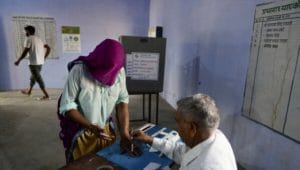The Indian elections, the biggest democratic exercise in the world, have begun. The 2024 Lok Sabha polls, unfolding over seven phases, will see 96.8 crore voters across the country flock to election booths.
The winner of this colossal endeavour is decided within the framework of the first-past-the-post (FPTP) system. However, the system is not just about counting votes. It also influences, to a large extent, who the winner will be.
Here’s an in-depth look at what the FPTP system entails for India.
What is the FPTP system?
India adopted the FPTP system from the British. Under this framework, a candidate only needs to secure more votes than their opponents to win.
This means that a candidate does not need the majority of the votes, i.e., over 50 per cent of the vote, to win. As long as they get even one more vote than the runner-up, they win the entire constituency and claim the seat in the Lok Sabha.
Here’s an example: In one constituency, X, there are 100 voters, and three candidates contesting for the seat. Let’s say Candidate A wins 37 votes, Candidate B wins 36, and Candidate C wins 27 votes. While Candidate A does not have an absolute majority, they will still have that seat and represent the entire constituency. That is, they will be considered the voice of 100 per cent of the people of that constituency, despite having the support of only 37 per cent of them.
In the Indian general elections, the FPTP system is followed in all 543 seats of the Lok Sabha. Then, these 543 members choose the prime minister of the country.
READ MORE:
Lok Sabha Election 2024: Almost 60 per cent voter turnout in Phase 1 amid sporadic violence
What are the criticisms of the system?
Over the years, several flaws have been highlighted in the system.
Wasted votes: The FPTP system, in many democracies where it is followed, has been criticised
for not being able to represent the interests of the majority of the population.
In the example of Constituency X mentioned above, the votes of 63 people, and in this case, 63 per cent of the population, are “wasted” since they find no expression or representation.
Promoting populism, vote bank politics: For elected representatives, this means that they do not need to work for all the people of the constituency. As long as they pay attention to the needs of the small number of people who did vote for them, they can still ensure they get re-elected. Thus, to remain popular and get re-elected, representatives often engage in vote-bank, competitive, or sectoral politics. Even political parties resort to populism and vote-bank politics to stay relevant.
Minimising opposition parties: Because of the FPTP electoral system, the opposition has been eliminated or reduced to a minimum several times in the past. For example in the first three general elections in India (starting from 1952), opposition parties claimed a good chunk of the people’s votes. However, this was not reflected in the Lok Sabha. The same happened in 1984 and 2014. Even in the 2019 elections, the Bharatiya Janta Party (BJP) managed to get over 50 per cent of the seats in Lok Sabha, despite garnering 37.4 per cent of the votes.
High barrier to entry for small parties: Smaller parties, especially those with dispersed support, may find it difficult to succeed in elections because of the winner-takes-all FPTP system. Unless their vote is concentrated in a constituency, they are unlikely to win a seat, even if they do enjoy some popular support.
What are the benefits of the system?
There have been repeated calls, especially from researchers and political scientists, to move to the Proportional Representation (PR) system. In such a system, the number of seats a party gets is dependent on the proportion or percentage of votes they secure.
Despite much criticism of the current system, and calls to shift to a different framework, India continues to stick to the FPTP framework.
But why?
There are multiple reasons for the popularity and success of the FPTP system.
Simplicity: The election system is easy to understand, even for the common voter who may not have any specialised knowledge about politics and elections. At the time of elections, voters are presented with a clear choice and simply have to endorse a candidate or a party while casting their vote. In the PR system, this choice becomes complicated because of the complex calculation involved in distributing seats.
Choice to vote for party and/or candidate: Depending on the prevailing political climate, voters may give greater importance to either the political party or the individual candidate, or strike a balance between the two. The FPTP system provides voters the option to choose not only between political parties but also specific candidates. However, in PR systems, voters are required to elect a political party and representatives are then chosen based on the party’s list.
Smooth functioning and stability: The FPTP system generally gives the largest party or coalition some bonus seats, more than their share of votes would allow. Thus this system makes it possible for parliamentary government to function smoothly and effectively by facilitating the formation of a stable government.
In a PR system, which promotes coalition governments, the fear is that there will be indecision, too many compromises, and even legislative paralysis.
Lack of political will: The ability to overhaul the system lies with those who come to power after the elections. However, largely, it is only those parties who have mastered their way around the present system that come to power. They have little incentive to change the framework that helps them.
Thus, for now, India remains on the path of the FPTP system.
Link to article –
Lok Sabha elections 2024: What is India’s first-past-the-post (FPTP) electoral system?
